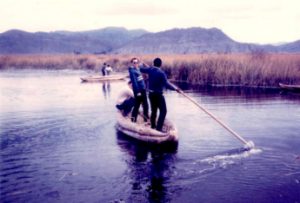Collection of Radioactive Samples from French Government Atmospheric Nuclear Tests May-September 1971

Sortie Number Katina Two
Crew:
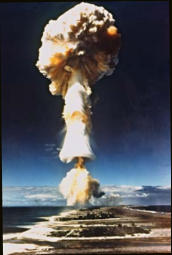 From 1966 to 1974 the French government conducted 41 atmospheric tests on the atolls of Fangataufa and Mururao in French Polynesia in the South Pacific. The tests were detonated on barges or from
From 1966 to 1974 the French government conducted 41 atmospheric tests on the atolls of Fangataufa and Mururao in French Polynesia in the South Pacific. The tests were detonated on barges or from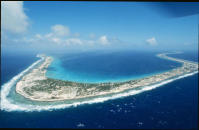 suspended helium balloons or dropped from aircraft. Each series contained up to 8 tests of triggers and warhead devices. The detonations produced clouds of atmospheric radioactive dust that the prevailing winds blew towards the coast of South America. Victor B2 (SR) aircraft of No 543 Squadron were modified to collect the radioactive dust and were deployed to the international airport at Lima, Peru to undertake air sampling when the radioactive cloud came within range. The collection was from the rear of the cloud where the radioactive intensity was lower.
suspended helium balloons or dropped from aircraft. Each series contained up to 8 tests of triggers and warhead devices. The detonations produced clouds of atmospheric radioactive dust that the prevailing winds blew towards the coast of South America. Victor B2 (SR) aircraft of No 543 Squadron were modified to collect the radioactive dust and were deployed to the international airport at Lima, Peru to undertake air sampling when the radioactive cloud came within range. The collection was from the rear of the cloud where the radioactive intensity was lower.
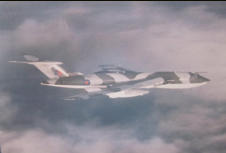 Engineers from AWRE Aldermaston had modified the detachment aircraft with air sampling and collection equipment at RAF Wyton prior to deployment. Filter baskets were fitted behind extension cones on the underwing drop tanks. They were electrically controlled, open and close,
Engineers from AWRE Aldermaston had modified the detachment aircraft with air sampling and collection equipment at RAF Wyton prior to deployment. Filter baskets were fitted behind extension cones on the underwing drop tanks. They were electrically controlled, open and close,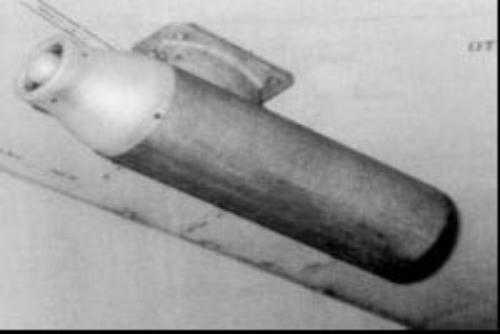 from switches on the AEOs panel. Radiation sensors were fitted on the airframe connected to meters on the AEOs d esk to measure radioactive intensity and provide coarse azimuth and elevation information. A selectable vacuum pump was fitted to the cabin conditioning system to provide additional filtering of air used for cabin conditioning and pressurisation once the cloud had been detected.
from switches on the AEOs panel. Radiation sensors were fitted on the airframe connected to meters on the AEOs d esk to measure radioactive intensity and provide coarse azimuth and elevation information. A selectable vacuum pump was fitted to the cabin conditioning system to provide additional filtering of air used for cabin conditioning and pressurisation once the cloud had been detected.
There were several deployments over the years, Operation Alchemist and Operation Aroma prior to 1971. In 1971 the operation was codenamed “Operation Attune” and a detachment of 3 aircraft and support personnel were deployed for 5 months, rotating personnel at the halfway point.
For this series the French government used Mururao Atoll, some 3600 miles from Peru. They were required to issue an international safety notice to mariners in the area prior to an event. This notification was used to bring the detachment to readiness. The detachment had its own Meteorological Officer who interpreted the weather data to forecast when and where the safest portion of the radioactive cloud would come within range. The first collection attempts would be at high level, 50,000 feet plus as this level came within range first due to stronger winds at altitude. If unsuccessful, subsequent sorties would step down in altitude.
On 7th June 1971 our crew were tasked as the second sortie against a French test. The first sortie was returning to Lima but had been unsuccessful in locating the radioactive cloud. After a short drive out of Lima we arrived at the international airport. Briefing was in an upstairs store room and conducted by 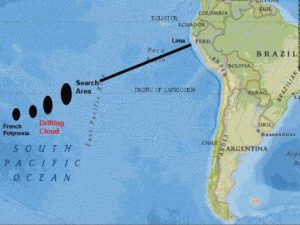 the Squadron Commander, Wing Commander Gordon Harper. His briefing team was formed from squadron aircrew, (doubling as reserves in case of crew sickness), the Met man and a 2-man team from Aldermaston, one a medical health specialist the other an equipment engineer. (I had been a team member and spare AEO for the previous year’s deployment, Operation Alchemist). The Met man and the Ops Team navigator had planned the route. The search profile was a “W” shape with the initial leg through the predicted trailing edge of the radioactive cloud and subsequent legs moving east to try and make contact. The aircraft would continue to fly the “W” until successful collection or fuel minimum reached to return to Lima. Diversion airfields were Santiago, Chile and Pisco, Peru. Our search altitude was to be as high as possible, up to 55,000 feet.
the Squadron Commander, Wing Commander Gordon Harper. His briefing team was formed from squadron aircrew, (doubling as reserves in case of crew sickness), the Met man and a 2-man team from Aldermaston, one a medical health specialist the other an equipment engineer. (I had been a team member and spare AEO for the previous year’s deployment, Operation Alchemist). The Met man and the Ops Team navigator had planned the route. The search profile was a “W” shape with the initial leg through the predicted trailing edge of the radioactive cloud and subsequent legs moving east to try and make contact. The aircraft would continue to fly the “W” until successful collection or fuel minimum reached to return to Lima. Diversion airfields were Santiago, Chile and Pisco, Peru. Our search altitude was to be as high as possible, up to 55,000 feet.
We were issued with individual dosimeters and photo sensitive badges. I was given a table of radioactive measurement figures for the sortie. These included the level at which to open the baskets to start collection, the maximum level to reach to close the baskets and an aircraft background figure. The aircraft were continually measured for their exposure to radioactivity during the detachment to establish their background reading. Their background reading affected the calculations of how much to collect and when to break off contact. It was important that sufficient samples were collected to meet the investigative requirement without over contaminating the aircraft so that it was not safe to fly for long periods.
We crewed out to the small complex beside the pans and aircraft. We changed into flying clothing in the blow up Igloo which housed our support personnel and mobile communications team. As it was to be a high altitude sortie, we dressed in G suit leggings under and a pressure jerkin over our flying overalls. These safety items would inflate if the cabin decompressed ensuring we remained conscious to enter an emergency descent whilst force fed with oxygen by pressure breathing. Finally, we waddled out to the Victor.
We were the only aircraft movement and got airborne at 0300 and ATC allowed us to turn directly towards the on task area. We climbed easily to 45,000 feet after take off then commenced the longer cruise climb to edge up higher as the fuel burned down. The task area was 3 hours away allowing plenty of time to get to 55,000 feet.
Just before reaching the start point we switched on the air conditioning vacuum pump and finished our rations, stowing them in thick polythene bags. No more food. Next each of us went through our safety drills- gloves on cuffs over the top, oxygen masks on, safety pressure selected (to ensure any mask leaks were outward), and neck covered. Then we started the search. For the first 3 legs the meters only registered the aircraft’s background count. As we reached the end of the leg the elevation meter flicked. I passed the information to Tom who headed roughly towards my bearing indication. Azimuth seemed OK which was fortunate as the aircraft was turning sluggishly and would probably not climb higher. The intensity meter had started to increase, indicating the presence of radioactivity in our vicinity. Soon the meter indication reached the briefed figure to open the collection baskets. As we rolled out I opened the baskets. Tom reported that he could see a yellowish cloud in the atmosphere around us in the early morning light. Roger plotted the position of the cloud. Between us we chased the dust cloud as I monitored the collection meter to ensure we broke off contact at the briefed figure. After another 30 minutes of collection the reading reached the come home figure and it was time to close the baskets and descend out of the cloud- job done and 3 hours back to Lima.
I passed the successful codeword back to Lima on HF (spooky- an action I was to repeat on Black Buck 1 some 10 years later!!). Not much to do on the long transit, no food to eat and oxygen mask clamped tightly on trying not to think of running water. I contacted ATC when in range and Tom’s approach and landing was uneventful. We were marshalled into an area set aside for successful collection sorties and ‘hot’ aircraft. Only the Aircraft Servicing Chief was allowed to approach the aircraft. He swabbed the external intercomm socket, ground power connection and door handle. We bagged our nav bags in poly bags and handed them to the Chief before climbing down the ladder. Gathering up all our equipment we waddled back to safety equipment. Everything was placed in a heap, we undressed and bagged our flying kit. All this was to be measured and monitored before we could use it again- in some cases destroyed. Finally, we took a shower and put on spare flying overalls. The Aldermaston specialists took control of the aircraft, removing the filter baskets and preparing them for safe transportation to the UK. They considered that a sufficient sample had been collected and the detachment stood down. We were ferried back to the accommodation in central Lima.
That night we did the rounds of our normal watering holes. I looked at myself and the crew to make sure that we were not providing the proprietors with free lighting and heating but no one was glowing- until the sixth Pisco Sour.

